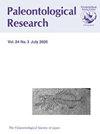日本群马县上新世原宿群雌雄蝇科化石一新种(鳞翅目,凤蝶总科)
IF 0.6
4区 地球科学
Q3 PALEONTOLOGY
引用次数: 0
摘要
摘要本文根据日本中部群马县上新世元居群的一个印象化石,描述和说明了一种新的蛱蝶科(鳞翅目,蛱蝶总科)化石,即netis kabutoiwaensis sp. nov.,这是蛱蝶科Limenitidinae亚科的第一个化石代表。此外,我们的研究还首次报道了在上新世系列中发现的一种命名的凤蝶科化石。该化石与Limenitidinae Neptini族具有前肢缩小、前翼盘状细胞开放、后翼Sc + R1脉短等特征。然而,前翼中CuP静脉的存在表明,所研究的化石明显不同于已知的nepletini部落物种。这是一个重要的发现,可以帮助我们探索上新世Neptini部落的进化,因为这个新物种的前翼可能具有CuP静脉的祖先特征。本文章由计算机程序翻译,如有差异,请以英文原文为准。
A New Species of Fossil Nymphalidae (Lepidoptera, Papilionoidea) from the Upper Pliocene Motojuku Group, Gunma Prefecture, Japan
Abstract. In this study, we describe and illustrate a new fossil species of Nymphalidae (Lepidoptera, Papilionoidea), Neptis kabutoiwaensis sp. nov., based on an impression fossil from the Upper Pliocene Motojuku Group, Gunma Prefecture, central Japan, which is the first fossil representative belonging to the subfamily Limenitidinae of Nymphalidae. In addition, our study is the first to report the discovery of a named Papilionoidea fossil from the Pliocene Series. The fossil shares characteristics, such as the reduced forelegs, open discal cell in the forewing, and short Sc + R1 vein in the hindwing, with the tribe Neptini of Limenitidinae. However, the presence of the CuP vein in the forewing suggests that the studied fossil is clearly different from known species of tribe Neptini. This is an important discovery that can assist us in exploring the evolution of the tribe Neptini during the Pliocene, because this new species has the possible ancestral characteristic of a CuP vein in its forewing.
求助全文
通过发布文献求助,成功后即可免费获取论文全文。
去求助
来源期刊

Paleontological Research
PALEONTOLOGY-
CiteScore
1.60
自引率
0.00%
发文量
47
审稿时长
>12 weeks
期刊介绍:
Paleonotological Research (PR) is a quarterly, peer-reviewed international journal, which focuses on original contributions primarily in the area of paleontology but also covering a wide range of allied sciences. It has been published since 1997 as a successor to the former journal Transactions and Proceedings of the Palaeontological Society of Japan. The emphasis of contributions will include global and local perspectives, and contents can cover all ages (Precambrian to the Quaternary, including the present time).
 求助内容:
求助内容: 应助结果提醒方式:
应助结果提醒方式:


